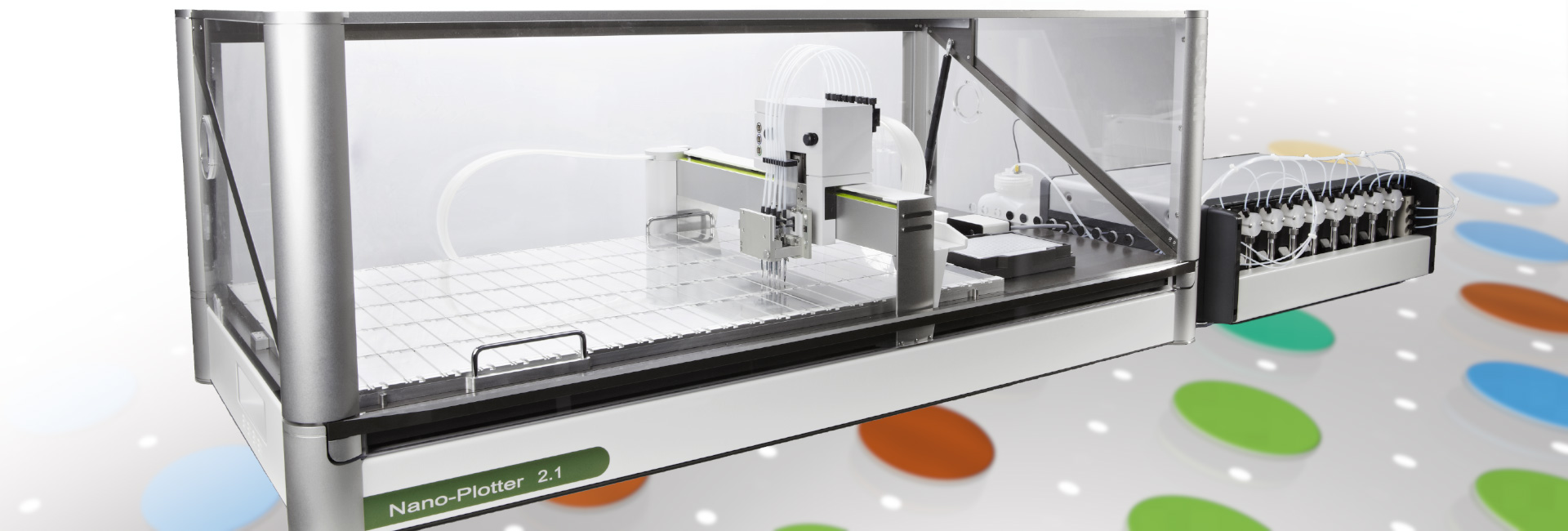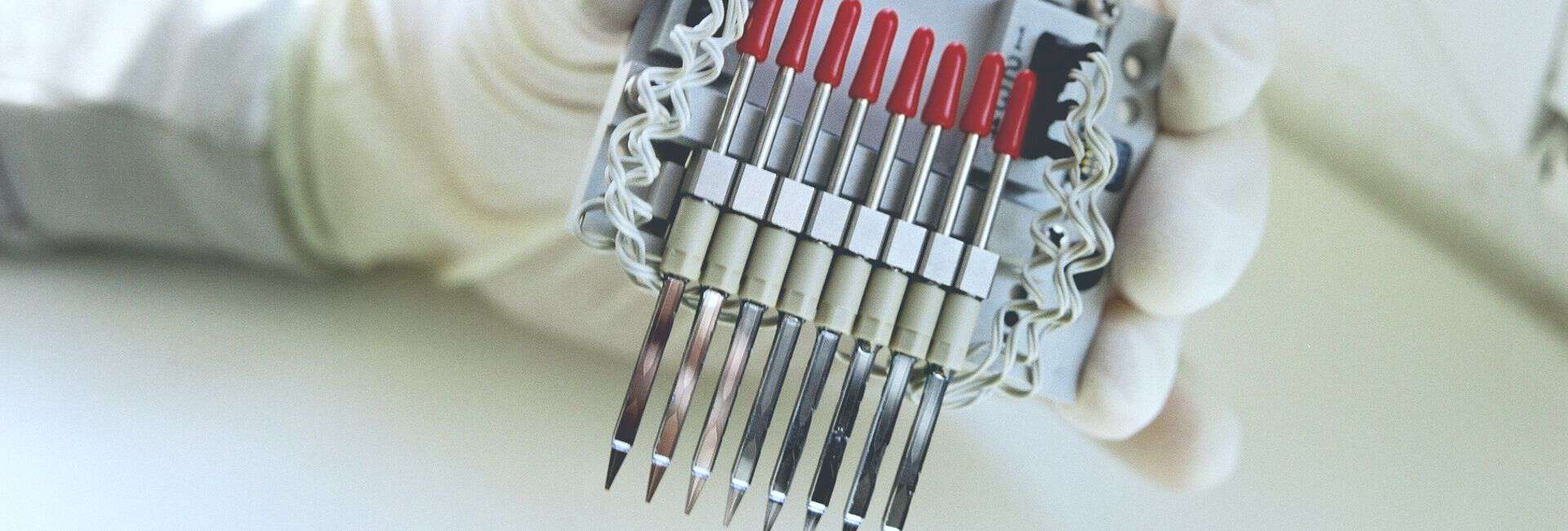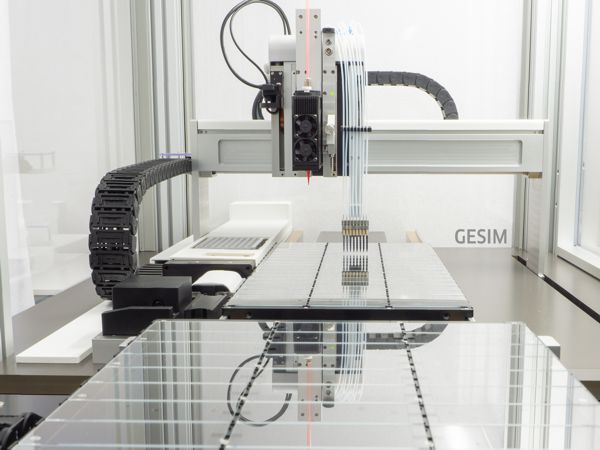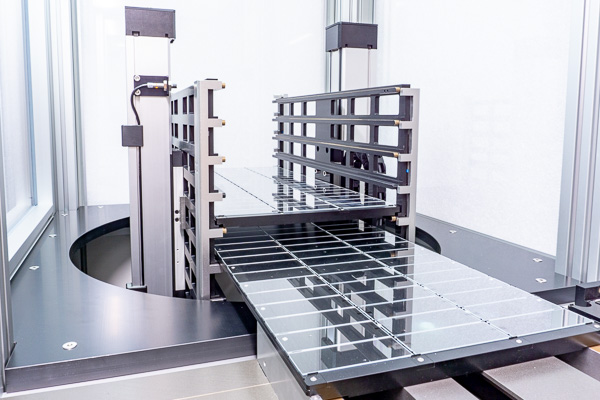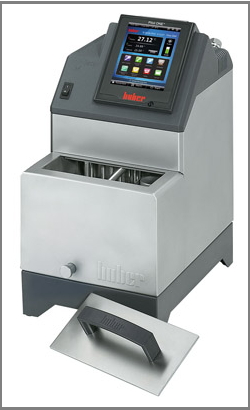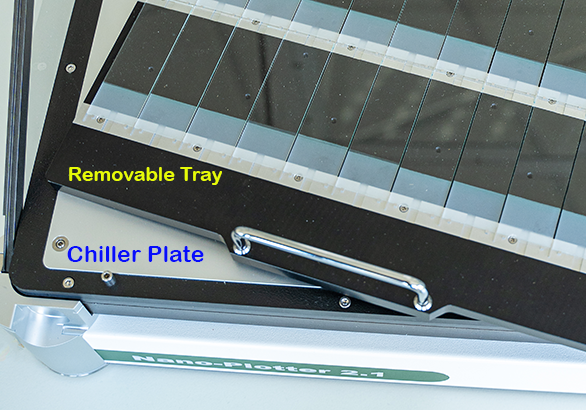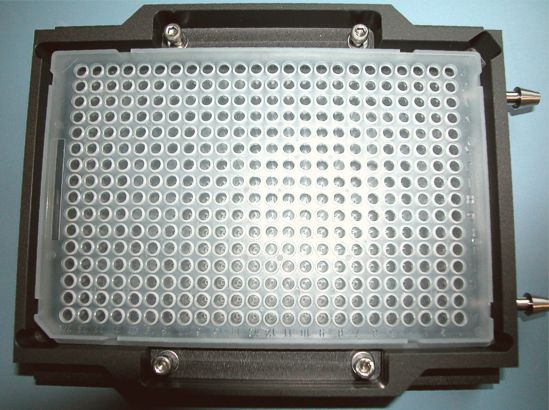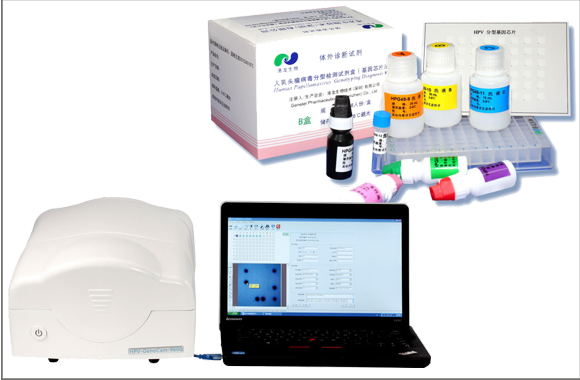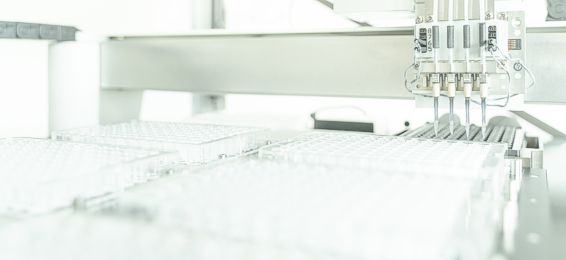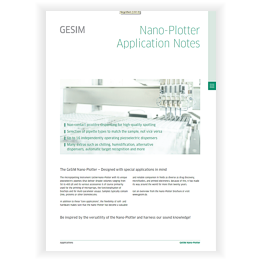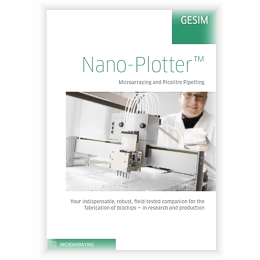Nano-PlotterTM: The Versatile Non-Contact Microarray Printers
Platforms NP2.x and NP7-HV
The Nano-PlotterTM covers different product lines for liquid handling featuring piezoelectric Nanolitre pipettes. They work with a wide range of (bio-)chemical substances. These drop-on-demand pipettes serve the full volume range from below a few Picolitres up to Microlitres.
The benchtop instruments Nano-Plotter NP2.1 and NP2.1/E are in worldwide use since many years. They are valuable research tools and production horses in the field of diagnostics (IVD) and almost all other branches of chemistry. NP2.1 basic model has a slide capacity of 44 slides but NP2.1/E accommodates up to 96 slides. Alternatively, 6 and 12 SBS well plates fit on the object trays of these instruments.
The Nano-Plotter NP7-HV (High-Volume) is an expandable and scalable mass production unit, available from mid-2021. It consists of NP7 workstations and tray stackers, all arranged in-line for unattended operation with large sets of slides, 96 well plates and other objects. Please subscribe to our Nano-Plotter newsletter for accompanying the launch of this exciting technology.
Numerous add-on modules (See tab ACCESSORIES) are available for each Nano-PlotterTM model. Particular cameras with image analysis software (See tab CAMERA-ALIGNMENT) support the deposition of tiny drops on biosensors, microfluidic cartridges and other patterned surfaces.
Common features of all Nano-Plotter models:
- 1 to 16 (8 for each NP7-HV workstation) independent piezoelectric pipetting tips in any combination. Post sales upgrade is possible.
- Sample aspiration from 96 well or 384 well micro plates
- Array density > 3000/cm2
- Dust cover (HEPA filter included with all NP7-HV units)
- Automatic wash/dry station
- Optical function test of each individual pipette tip after sample aspiration
Each Nano-PlotterTM can be configured to a particular application. And… it can grow! The number of pipetting channels can be upgraded after sales. The workstations in-line with a NP7-HV setup can be extended when production throughput increases. All GeSiM Nano-PlotterTM are capable of more than rectangular microarrays: They draw lines on NC membranes, dispense exact volumes into microfluidic cartridges, pipets smallest liquid amounts into wells, offer real-time mixing of tiny drops. The NP7-HV can be equipped with any dispense tool for high-viscous substances known from the GeSiM bioprinters. The BioSyntheSizer contributes with powder dispensers and mechanical handling tools.
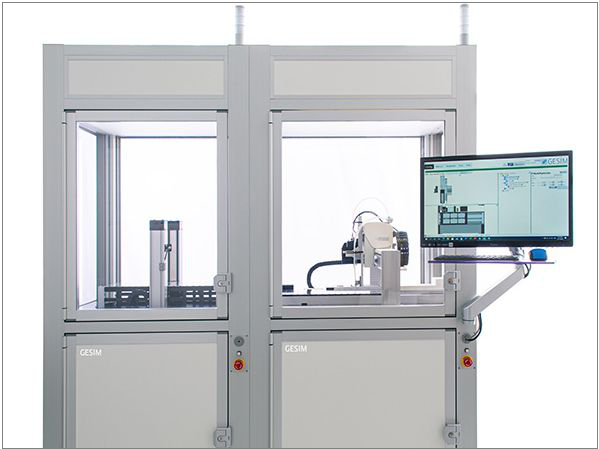
NP7-HV starter setup with one magazine module (left) and one process module (right)
Pipet Tools for all Microarray Printers
Each Nano-PlotterTM comes with piezoelectric pipetting tips for the software-controlled deposition of particular drop bursts (From 60 Picolitre). They consist of glass and silicon- valve less and fabricated from micro structured glass/silicon wafers. Mechanical robustness is much better compared to dispensers made from glass capillaries. Biochemistry and diagnostic applications often require to handle samples with varying consistencies. Piezoelectric pipet tips for different drop volumes and viscosity ranges let your Nano-PlotterTM meet challenging liquid handling tasks in Life Sciences.
Our microarray printers can bridge the gap from Picolitre range (piezoelectric tips) to Microlitre pipetting: Solenoid valve dispensers for drop volumes from 50 Nanolitres draw lines on Nitrocellulose membranes for more traditional point-of-care products. Third party piezoelectric dispense valves accept high- viscous samples like glues and UV-curable resists (2.5D prints for microfluidics and MEMS technology). Positive displacement dispensing delivers Microlitre volumes to cavities/wells. Most of these pipet tools are available with built-in heaters.
Each Nano-PlotterTM offers a so called “Spot-On-the-Fly” mode (SOF) for microarraying applications with single drop per spot position on planar objects. Particularly when processing a large set of identical plain objects (E.g. glass slides) SOF saves up to 50% time compared to the stop-and-go-approach.
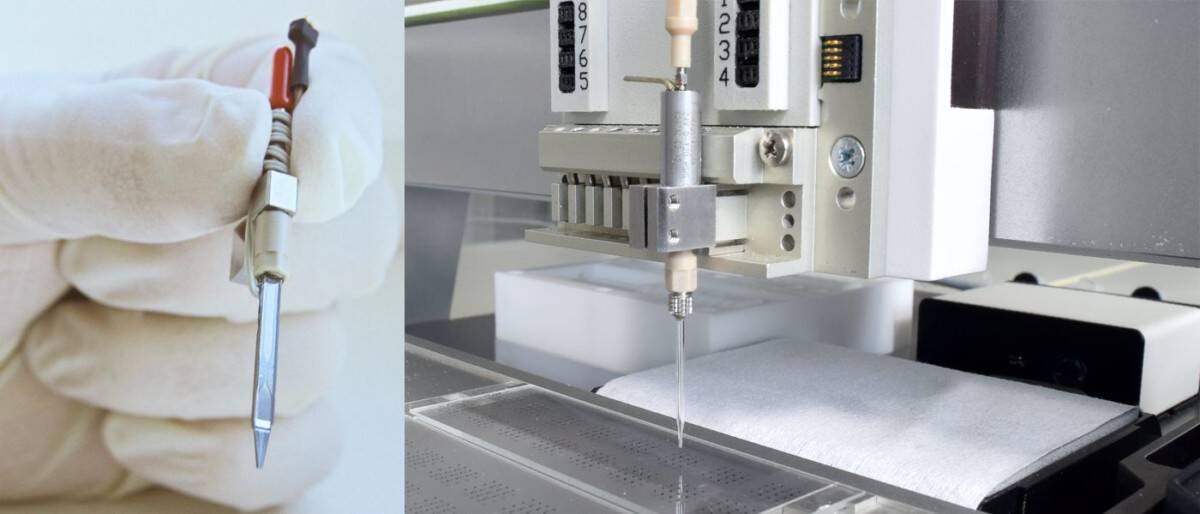
Most popular tips for the microarray printer: Piezoelectric pipet (left); solenoid valve (right)
Piezoelectric Tips for the Picolitre range
- Nano-Tip J: 0.4…0.7 Nanoliter
- Nano-Tip A-J: 0.25…0.4 Nanoliter
- Pico-Tip J: 0.08…0.1 Nanoliter
- Nano-Tip J-H: 0.4…0.7 Nanoliter (External heater unit required)
- Pico-Tip J-H: 0.08…0.1 Nanoliter (External heater unit required)
Tips with special design:
- Nano-Tip HV-J: For high-viscous samples
- Nano-Tip AR-J: Reduced cross section of the pipet body, for array printing into 96-well plates
Solenoid Valve Pipetting Tips (Option):
- 40…350 Nanolitre drop volume
- Affordable glass nozzle for low operational costs
- Upgrades available for all Nano-Plotter types
Sample Management & Maintenance on Board of a Nano-PlotterTM
All piezoelectric pipet tips aspirate from 96well plates and 384 well plates. The aspiration volume depends on the spotting application, hard- and software of each GeSiM instrument are optimized for automatic sample loading, intermediate washing and final rinsing of the precious micro pipets.

Onboard Tip Monitoring
The Nano-Plotter aspirates from both 96well and 384 well plates. Sample loading is validated by an automatic optical dispense test. A stroboscope camera checks for:
- Deflection of the main droplet from the vertical
- Droplet size, count and speed
- Deviation of satellite drops from the main jet
Print head configurations with multiple tips as well as large sample sets benefit from the onboard tip monitoring. The result of each test is monitored for quality recording and GMP. Optionally microfluidic sensors are available for more accurate drop volume measurement.
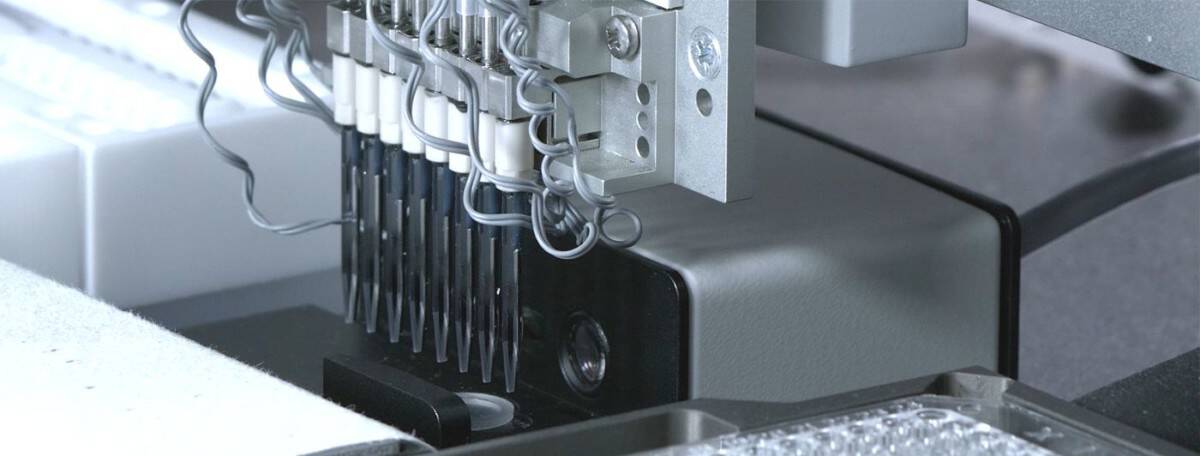
Print head with eight piezoelectric tips during strobe test
The Tip Wash System of the Nano-Plotter
Unlike disposable tips, GeSiM pipettes are reused for subsequent samples and therefore require thorough washing. Optimization implies the finding of the smallest wash time at which no contamination is detected.
Dispensing of template DNA into Taq master mixes with subsequent thermocycler treatment revealed five seconds wash time to be sufficient to avoid any carryover.
Proteins are more critical, as they exhibit different solubilities and hydrophilicities. Certain hydrophobic peptides and proteins apparently are not washed away by water alone. In this case, a software function called “extra wash” or a second wash bowl using weak base or detergent must be employed. It is a good habit to perform such an extra wash at least after each run of protein spotting.
Organic solvents, aspirated from dedicated reservoirs, ensure the complete wash-off of polymer solutions from the piezoelectric tips.
Please ask us for more information on this topic.
Tools & Trays: Flexibility for changing Requirements
Each Nano-PlotterTM NP2.x configures individually, with one up to sixteen pipet channels in any combination. NP2.x instruments are optimized for low-viscous samples and Pico-/Nanolitre range.
The ground-borne NP7-HV runs up to eight piezoelectric nozzles on each workstation. The tool heads of these workstations also adapt (heatable) pneumatic extruders, tip ejectors for displacement pipets, powder dispensers, vial handlers and much more.
Climatization matters, specifically for low-volume liquid handling. With our accessory lines humidity and temperature can be set for the chamber of each Nano-PlotterTM.
Please contact us for full catalogue with all technical details and specs.
Exchangable Target Trays
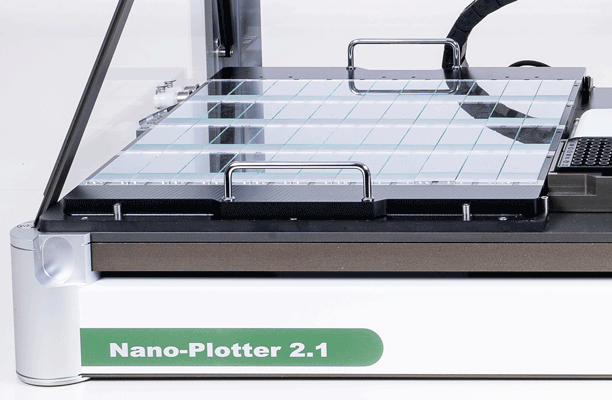
The universal tray for NP2.1 accomodates either up to 44 slides, six SBS format plates or a combination of both
For fast and easy replenishment of targets, the Nano-PlotterTM adopts slides, Nitrocellulose membranes, microfluidic chips, 96 well plates and more. The target trays touch down on the instrument surface by a comfortable click-and-go mechanism. Tray surfaces for customized formats are available on request.

Eight-fold flow sensor for drop volume measurement
Naturally, the performance of the piezoelectric tips is affected by the consistency of the sample. GeSiM developed microfluidic sensors to measure the liquid flow in the fluidic back path of each channel. The sensors are valuable tools to tune the microarray printer for special liquids and to match drop volumes of multiple tip configurations.
Real-Time Monitoring of individual Spots on the Nano-Plotter
The extension of the camera check for monitoring of each individual spot on the targets is of interest with regard to regulatory requirements and for the management of “difficult” samples.
The real-time spot detection is based on a backlit object tray in combination with a powerful camera. The software recognizes the liquid drop before it becomes a dry spot. Smallest drops (Pico-Tip) can be detected reliably. Nature and composition of the liquid sample doesn’t matter.
The real-time spot detection currently requires optical transparent targets, e.g., glass slides, plastic chips, NC-membranes or slides with NC-pads on top.
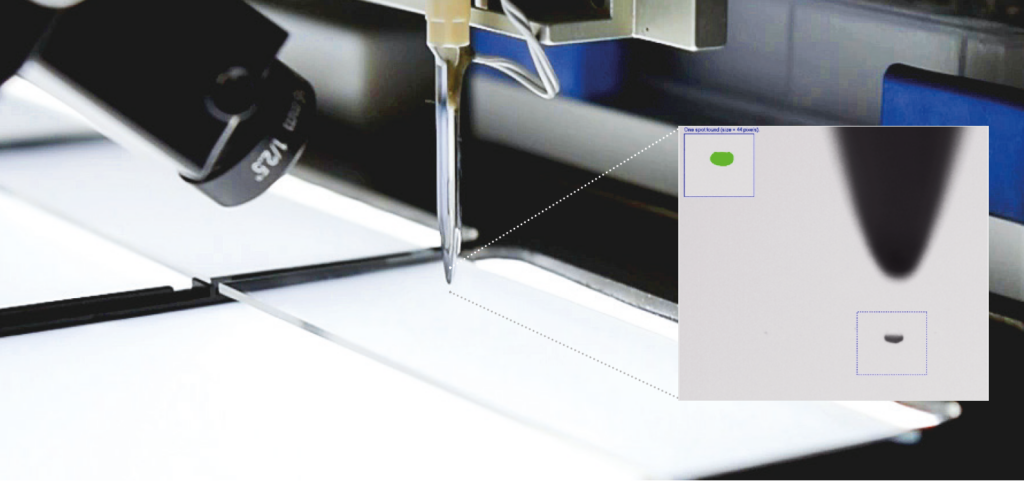
Real-time spot detection of a single spot on a glass slide
External units for chilling and humidifying allow establishment of conditions close to the dew point. The ultrasonic humidifier connects directly to the hood enclosure of the instrument, thus even microliters of samples can remain on the deck of the instrument with minimum evaporation losses.
Both the coolable base plate underneath the slide tray (Second picture) and the microplate holder (Third picture) connects to a recirculating chiller to control the temperatures of both the samples and the targets. Thermal coupling between adapter and well plates depends both on the plate model and on the adapter – read our related Application Note.
TwinTip – Pipetting and Mixing of Tiny Droplets
Chemical reactions at a microscale and hardening of two-component systems are just two applications for the TwinTip adapter for the Nano-Plotter. Dispense tips assembled to the TwinTip adapter allows to aspirate tiny volumes of two different species from a standard micro well plate.
The TwinTip adapter accommodates the native GeSiM piezoelectric pipets as well as solenoid dispense valve pipets. Following setups are possible:
- Two GeSiM piezoelectric pipets with drop volumes between 60 pL and 400 pL
- Two solenoid valve pipets with droplet volume of 50 nL
- One GeSiM pipet, one solenoid valve
The TwinTip adapter toggles the pipets between two positions: OPEN (Aspiration/ wash position) and CLOSE (Dispense position). Simultaneous drop release at the CLOSE position leads to a perfect mix up of both drops on the target surface due to the high kinetic energy of the drops.
More than a Microarrayer – Customized Configurations
Besides array spotting, GeSiM has the flexibility and capability to create custom instruments on request. The Nano-PlotterTM software comes with an open user interface for the development of liquid handling applications by the customer.

Third party dispensers and other tools on the Nano-Plotter print head
In addition, GeSiM develops and delivers OEM Versions of the Nano-PlotterTM to other instrumentation manufacturers.
| – Heatable piezodispensers – Dispensers with reservoir cartridges on top – Dispensers for high-viscosity media – Passive Microliter dispensers |
– Plate hotel for large samples sets – Vacuum tweezers – Wash system for dedicated cleaning solutions – Print head camera for process observation |
As an example, microarray spotting can be accomplished by Microliter liquid handling or manipulation of mechanical parts like glass lids. For manufacturing of a large number of identical arrays with a limited set of samples we recommend piezoelectric tips with an integrated reservoir.
Benchtop lab automation exceeding liquid handling is available with the GeSiM BioSyntheSizer.
Optical Target Recognition
The typical drop diameter of 50 Microns of the Nano-PlotterTM piezoelectric tips is well appropriated to apply Nanolitre amounts of liquid to target structures of similar size. However, nozzle alignment to tiny targets may become challenging.
The Optical Target Recognition system is based on two aligners on each target object. Arbitrary spotting positions can be defined relatively to the aligners. The camera identifies the exact position of the aligners on each individual target and calculates the current coordinates of the dispense positions.
An image analysis software is able to identify aligner patterns like microelectrodes, nanowells and microcantilevers. Alternatively the aligner positions can be determined by mouse click.
Procedure
The following video demonstrates the alignment process for individual piezoelectric tips. Initially a “spotting plan” is required for each target layout.
- First the XY offset of the camera axis to the drop trajectory of each dispenser has to be determined.
- Now the camera travels to each of the two alignment markers on each target. Two pictures are taken of each target substrate.
- The software calculates the coordinates for each spot point individually for each target and completes the spotting run without any further user interaction.
Customer Service is our Highest Priority!
Customer specifications for microarray printers in a research environment differ from industry-related requirements, e.g. for a GMP-based facility. During the last two decades we listened to our customers, GeSiM microarray printers now incorporate features for both sides: Flexibility guarantees success for researchers, whereas thorough logging functions and user-friendly interfaces support the 24/7 production of POC products and diagnostics.
Nanolitre pipetting machines from GeSiM are customizable: Click-on target trays are available for any format; sophisticated camera systems make the work with microfluidic cartridges reliable. Particularly Nano-Plotter 7 runs our piezoelectric pipets as well as all other tools available from GeSiM. It is the perfect choice for more complex production lines.
We work with our clients towards a predefined goal. Based on an initial phone conference or visit, we accept your printing material for free feasibility tests. Finally, GeSiM instruments ship along with customer specific tutorials for a particular application, onsite training makes sure you succeed right from the beginning.
You cannot afford an own microarray printer? To a certain extent GeSiM offers spotting services with your material. Please contact us.
Customers around the globe trust in well-proven GeSiM technology for years. Here we present just a few selected cases, please ask for more details.

Typical fluorescence image of a microarray
DNA Microarrays for IVD and Research
DNA microarrays are usually based on application specific oligos, suspended in aqueous buffers. Custom oligos are available quickly, with physical properties well appropriated for the piezoelectric GeSiM pipets. With high-quality microarray glass slides, dense packed DNA microarrays (>> 1,500/ cm2) can be spotted with each Nano-PlotterTM model. Our instruments support all other formats as well, e.g. NC-membranes, membrane coated glass slides and 96well-plates.
Genetel Pharmaceuticals Ltd., Shenzhen (CN), developed an HPV Genotyping Kit for the detection and identification of 26 HPV Genotypes, covering 99% of clinical prevalent HPV genotypes. The kit uses advanced gene chip technology and detects in one reaction tube, automatically collects images, analyses data and generates inspection reports with a dedicated instrument.
Human Papilloma Viruses (HPV) belong to a group of DNA viruses which may affect epithelial cells of skin and cause different types of cancer.
Genetel runs a DNA array production facility with multiple GeSiM Nano-PlotterTM NP2.1/E instruments. DNA is spotted on membranes.
Microarrays for Immunoassays
Protein microarrays became a popular application for the GeSiM Nano-PlotterTM. Generally, protein solutions are more challenging for piezoelectric micropipettes due to more viscous buffers and a tendency of proteins to stick to glass surfaces. However, the wide range of different types of piezoelectric GeSiM pipets, along with thorough on-board washing, provides utmost flexibility for arraying of antibodies, antigens and other biomolecules.
Sunlant bioengineering Co., Ltd., developed a tumour marker test kit, based on a chemiluminescent immunoassay. It combines chemiluminescence technique with immunochemical reactions. The Twelve Tumour Marker Test Kit is available for Males/ Females and uses patient serum. Sunlant developed analysis instruments for high throughput (400…700 patients/hours), addressing the needs of hospitals and clinical labs. A bunch of Nano-PlotterTM NP2.1/E instruments is in use for the production of the heart of these kits, a protein array on a glass slide.

Production of protein microarrays at Sunlant, P.R. China
Courtesy of:
Sunlant bioengineering Co., Ltd., Xinwu District, P.R. of China
Multiplexed Assays based on 96-Well Plates
96-well plates are popular for drug development and diagnostic assays. Miniaturization of liquid handling is the key to multiplexed assays. It allows the detection of several analytes per well. Plates with specific coatings support the printing of arrays of different biomolecules onto the well bottom. (Micro)-ELISA (enzyme linked immunosorbent assay) is one application: It is a sensitive and specific method for immunological diagnostics. More methods for Genotyping and DNA analysis are also established for the 96-well format.
GeSiM microarray printers can be configured for arraying on the bottom of standardized 96-well SBS-plates. Dedicated plate trays are available as well as 2-row print heads, matching the 9 mm pitch of these plates. GeSiM has developed an optimized piezoelectric pipet (Nano-Tip AR-J) with slimmer design for better access to each individual well. The highest achievable spot density is significantly dependent on sample type and surface properties of the plate.
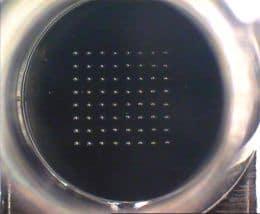
8×8 spots, single drop each
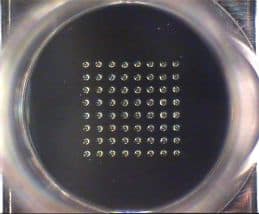
8×8 spots, five drops each

8×8 spots, 10 drops each
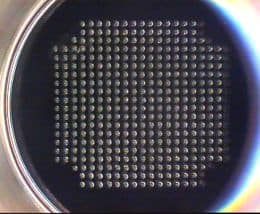
368 spots, single drop each
The plate capacity of the smaller NP2.1 is between six and eight but NP2.1/E accommodates between 12 and 15 plates. One stacker of NP7-HV accomodates up to 60 plates.
For high-througput applications we recommend 96-well plates with detachable grid, it saves time required for the many ups and downs of the print head.
Cell Lysate Microarrays – From Cells to Protein Profiles
The usual protein microarray is an arrangement of specific antibodies or antigens tethered to solid surfaces. The reverse phase protein array (RPPA) does the other way: Microarrays with individual cell lysate spots of 130 µm diameter, representing 1 to 10 cell equivalents each, are being produced using the robust piezo-electric non-contact deposition method of the Nano-PlotterTM. After incubation, signals are generated by fluorescently labelled specific antibodies. Due to the extremely low sample consumption of the spotting process large numbers of replicate arrays can be produced and thus allow the efficient determination of substantial numbers of proteins.
With respect to the physical and fluidic properties of cell lysates reproducible microarraying can be a challenge. GeSiM microarray printers are well suited, being in worldwide use with this specific application.

Scheme of the RPPA microarray process (© Zeptosens AG, Switzerland)
A highly sensitive optical detection method based on glass chips with linear wave guides was developed by NMI Reutlingen, Bayer Technology Services and others.
Applications:
- Identification of disease relevant marker proteins in cultured cells, tissues, micro dissected material as well as depleted serum and urine
- Determination of dose efficacy and IC50 of drug candidates
- Quantification of cell signalling pathway activation / inhibition with a precision of better than 20%
- Monitoring phosphorylation changes on multiple kinase
More information on this technology is available from Bayer Technology Services, Leverkusen (Germany)
Electrical Biochips – The Comfortable Way of Detecting Biomolecules
A special camera system of the Nano-PlotterTM, along with image analysis software, aligns the piezoelectrical tips to small wells or planar features of sensor chips. For details please refer to the third tab “CAMERA-ALIGNMENT”.
The department “Biotechnical Microsystems (BTMS)” of the Fraunhofer ISIT developed an electrical biochip technology without marker-based detection. The electrical biochips offer intrinsic advantages because of particle tolerance and mechanical robustness by the direct transduction of biochemical reactions into electrical current. The use of gold electrode arrays combined with integrated reference and auxiliary electrodes along with sensitive, selective measurement techniques like “Redox-Cycling” enables powerful sensor systems. These arrays are useful for the detection of a variety of analytes within one sample simultaneously. User-friendly operability is realized by integrating the biochips into cartridges. In combination with micro-fluidic components and integrated electronics, these electrical microarrays represent the basis of rapid and cost-effective analysis systems. They can be used to identify and quantify DNA, RNA, proteins, whole cells as well as haptens.
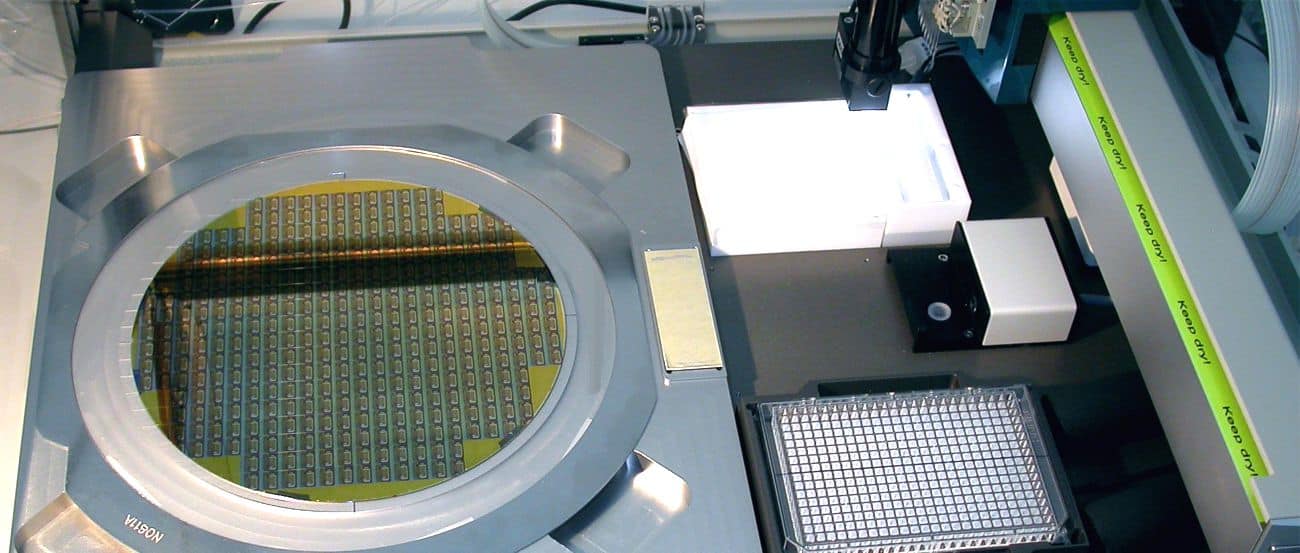
The used array chips consist of 16 gold electrodes for immobilizing capture molecules and the final electrochemical read out. These positions are 350 µm in diameter and therefore the capture molecules have to be deposited position specific by a piezodriven nanodispensing device (GeSiM Nano-Plotter).
With Courtesy of Dr. Eric Nebling, Fraunhofer ISIT, Fraunhoferstraße 1, 25524 Itzehohe
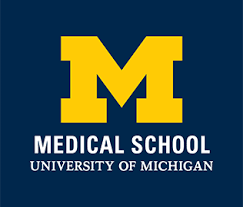 The Nano-Plotter was used to study Post Translational Modification Changes as a Function of Disease (Tasneem et.al.) at the University of Michigan, Medical School.
The Nano-Plotter was used to study Post Translational Modification Changes as a Function of Disease (Tasneem et.al.) at the University of Michigan, Medical School.
Protein glycosylation has been implicated in key biological processes including immunological recognition, cellular adhesion, protein folding, and signalling as well as disease progression.
Background
Complementary to the popular antibody arrays, this application uses pre-separated proteins from cellular lysates or other bio-fluids. The resulting arrays are probed with agents that can specifically detect certain post translational modifications. Differences in modifications between different disease states can therefore be highlighted.
Method
Glycoproteins from serum samples can be enriched and separated by nonporous reversed-phase HPLC. Separated proteins are then arrayed on nitrocellulose slides and probed with multiple types of lectins using a biotin-streptavidin platform to detect glycan structures present in the glycoprotein.
This gives one the capability to monitor global glycosylation pattern changes as well as identify otential new proteins whose glycosylation changes are essential in biologically important states.
Tasneem Patwa
University of Michigan Medical Center, Department of Surgery, MSRB I, A510B
Lubman Research Laboratory
1150 W. Medical Center Drive
Ann Arbor, MI 48109-0650
USA
Nano-Plotter – Special Applications
The pipetting instrument Nano-Plotter with its unique piezoelectric GeSiM pipets is primarily used for functionalization of biochips, printing of microarrays and Nanolitre pipetting for multiple parameter assays.
Beside of the “core applications”, the flexibility of soft- and hardware makes the Nano-Plotter a versatile companion in fields like drug discovery, fine chemicals, microfluidics, and printed electronics. A few of possible applications are shown in the pdf brochure below.
- Bulk dispensing with piezoelectric GeSiM pipets
- Printing of geometries besides of single spots
- Printed electronics
- Microfluidics and 3D structures

